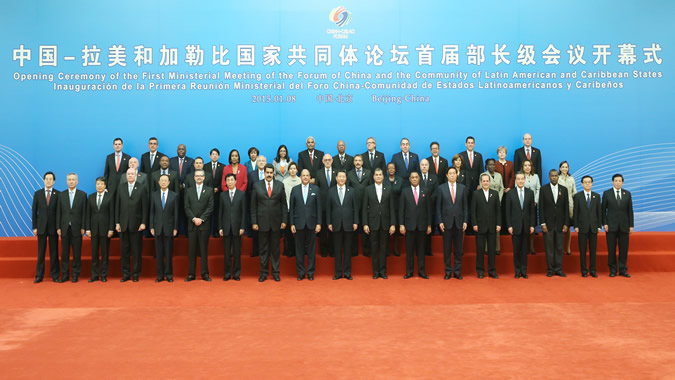Latin America and the Caribbean Has a Historic Opportunity to Strengthen Ties with China
Work area(s)
The Executive Secretary of ECLAC, Alicia Bárcena, is taking part in the first China-CELAC Forum in Beijing.

(8 January 2015) The economic reforms under way in China are a historic opportunity for the region to make a qualitative and quantitative leap forward in its economic and trade relations with the Asian power, thereby tackling its infrastructure, innovation and human resources challenges; raising its productivity and competitiveness; and diversifying exports – according to a new report from the Economic Commission for Latin America and the Caribbean (ECLAC).
The document First Forum of China and the Community of Latin American and Caribbean States (CELAC): Exploring opportunities for cooperation on trade and investment was presented today by the Executive Secretary, Alicia Bárcena, as ECLAC’s contribution to the First CELAC-China Forum being held from 8 to 9 January in Beijing, China.
CELAC is the most appropriate body to help the region face new challenges on the horizon. According to the publication, while national initiatives are necessary, they are clearly insufficient when it comes to becoming a relevant economic and trading partner for China.
Between 2000 and 2013, China went from being a minor partner of Latin America and the Caribbean to a key player. The mutual trade in goods increased 22 fold from just over 12.0 billion dollars to almost 275.0 billion dollars. By way of comparison, the region’s trade with the world only tripled during that time.
Since 2012, China’s economic growth rate has slowed. Its reforms are taking it towards a development model based more on household consumption, rather than exports and domestic investment.
The document stated that overcapacity in some industries, rising labour costs and the quest for safe and profitable opportunities to invest surplus savings should lead to greater capital outflows from China, in keeping with the guidelines expressed by the country’s authorities.
In order to solve the ongoing expanding trade deficit with China, Latin America and the Caribbean could attract this new foreign direct investment (FDI) towards sectors other than extractive industries (which accounted for almost 90% of estimated Chinese FDI between 2010 and 2013). Examples of new sectors would include services, infrastructure, energy, transport and logistics.
Latin America and the Caribbean offers interesting opportunities for such capital, including a growing consumer market, proximity and preferential access to the United States and an abundance of natural resources. The agriculture and agrifood sectors, for instance, have huge potential. The region could play a strategic role in China’s food security (as the country has 7% of the planet’s farmable land and 6% of water resources to feed 22% of the world population). The challenge for governments lies in defining a consensual portfolio of projects where Chinese investment would be most useful.
The region’s FDI towards China is at an early stage and could enter new market niches that are opening up with Chinese social developments in areas such as agroindustry and services relating to tourism, entertainment, architecture, town planning, environmental management and services for older adults.
According to the report, the main challenge facing Latin American and Caribbean countries is to create stronger links between the ties with China (and Asia in general) and domestic policies regarding innovation, competitiveness, science and technology, infrastructure, trade facilitation and business internationalization.
Related content

“It Is Vital for the Region to Forge Closer Strategic Ties with China”
Alicia Bárcena, Executive Secretary of ECLAC, took part in the China-CELAC Forum and held meetings with Chinese authorities and academics.
Related link(s)
Country(ies)
- Latin America and the Caribbean
- China
Contact
Public Information Unit
- prensa@cepal.org
- (56 2) 2210 2040
